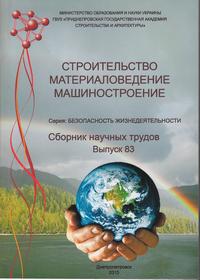Undermined areas as a factor influencing on the forces of ferroconcrete elements of a wireframe building
Keywords:
undermining areas, the base stiffness factor, the forced displacement of the base, additional efforts, the ferroconcrete elements.Abstract
Objective. To investigate the influence of base pliability on the distribution of additional forces in ferroconcrete elements of the wireframe buildings from a ground deformation on the undermined areas. The usage of reinforced concrete in almost all areas of construction has taken a vast scale. This is due to its durability, the ability to make extensive use of local construction materials, and to apply profit-proved constructions with low consumption of the metal. Tecnique. The accounting algorithm is based on the basement prototyping of the core elements with the rigid characteristics, depending on the stiffness factor of the base. Stiffness characteristics of the bar section, which simulate the buildings' constructions were made in accordance with educational supplies and were not changed in the accounting process. The accounting was performed using the software package LIRA based on the finite element method. The accountings were performed on the main (constant + temporary + wind left) and a special combination of loads (undermining impact). Results. The application to the descent of the base rigidity can be used in combination with the application to stiffening of the constructive building elements or additional elements, which allow to take the undermining forces, e.g. in combination with tie elements and distance bars. The amplification of a basement suppleness is efficient to effect by applying self-regulating foundations with limited rainfall by maximum allowable value. In a view of this the essential base stiffness decline may occur through the formation under the bottom of a self-regulating sole foundations of temporary, local sliding areas of the soil. Scientific novelty. An improved method of wireframe buildings accounting on undermined areas, unlike the previous ones, which were based only on a linear accountings. The practical significance. The usage of the non-linear accounting method will allow to account the ferroconcrete elements of wireframe buildings more accurate. Additional forces in the fabric elements from the undermining influence may be substantially higher than the forces of the main load combinations, and lead to the destruction and loss of stability of individual structures as well as buildings in general. Maximum further efforts from the undermining effects will appear mainly from the horizontal ground deformation. The maximum additional bending moments and transversal forces arise in end columns and beams of the first floor and the maximum axial forces in the secondary beams of the first and second floors.
References
ДБН В.2.1-10-2009 Основи та фундаменти споруд. Основні положення проектування/ Мін. буд. України. Київ 2009, 107 с.
ДБН В.1.1-5-2000 Здания и сооружения на подрабатываемых территориях и просадочных грунтах. Часть 1. Здания и сооружения на подрабатываемых территориях. – Киев: Госстрой Украины, 2000. – 64 с.
Руководство по проектированию зданий и сооружений на подрабатываемых территориях. Ч II. Промышленные и гражданские здания./ НИИСК Госстроя
СССР, Донецкий ПромстройНИИпроект, КиевЗДНИИЭП, КиевНИИП¬градостроительства. – М.: Стройиздат, 1986. – 304 с.
Клепиков С.Н. Расчет сооружений на деформируемом основании, Киев-1996, 206 с.
Рекомендации по расчету пространственных систем зданий и сооружений на подрабатываемых территориях / А.А. Петраков, Ю.И. Мальцев. – Донецк: Ротапринт Донецкого ПромстройНИИпроекта, 1984. – 87 с.
Методические рекомендации по определению коэффициентов жесткости оснований зданий и сооружений / НИИСК Госстроя СССР. – Киев: 1977. – 30 с.
Компьютерные технологии проектирования железобетонных конструкций: Учебн. пособие / Ю.В. Верюжский, В.И. Колчунов, М.С. Барабаш, Ю.В. Гензерский. – К.: Книжное изд-во НАУ, 2006. – 808 с.
Пат. 34886 Украина, МПК 6 Е 02D 27/00 Фундамент будівлі, споруди: Петраков А.А., Азараев В.В., Тимченко Р.О. № 99074068; Заявл. 15.07.1999; Опубл. 15.03.2001, Бюл. №2. – 4 с.
Тимченко Р.А., Кришко Д.А. Работа плитных фундаментов-саморегуляторов на неравномерно-деформируемом основании. – Современные проблемы строительства. – Донецк: ДП Донецкий ПромстройНИИпроект, 2010, с. 83 – 91.
Марченко Д.В., Титок В.П. Лира-Windows Руководство пользователя: НИИАСС «Научно-исследовательский институт автоматизированных систем в строительстве Госкомградостроительства Украины», 1997- 245с.
Яркин В.В. Определение осадок фундаментов за пределом линейной деформируемости основания. – Будівельні конструкції. - Київ: НДІБК. - 2003. вып. 58. - с. 217 – 222.
Быховцев, В.Е. Компьютерное моделирование систем нелинейной механики грунтов / В. Е. Быховцев, А. В. Быховцев, В. В. Бондарева. – Гомель: Гомельский государственный университет им. Ф. Скорины, 2002. – 215 с.
Downloads
Published
Issue
Section
License
Редакція Видання категорично засуджує прояви плагіату в статтях та вживає всіх можливих заходів для його недопущення. Плагіат розглядається як форма порушення авторських прав і наукової етики.
При виявлені у статті більш ніж 25% запозиченого тексту без відповідних посилань та використання лапок, стаття кваліфікується як така, що містить плагіат. У цьому випадку стаття більше не розглядається редакцією, а автор отримує перше попередження.
Автори, в статтях яких повторно виявлено плагіат, не зможуть публікуватися в усіх журналах Видавництва ДВНЗ «Придніпровська державна академія будівництва та архітектури».
Автори, які публікуються у цьому журналі, погоджуються з наступними умовами:
- Автори залишають за собою право на авторство своєї роботи та передають журналу право першої публікації цієї роботи на умовах ліцензії Creative Commons Attribution License, котра дозволяє іншим особам вільно розповсюджувати опубліковану роботу з обов'язковим посиланням на авторів оригінальної роботи та першу публікацію роботи у цьому журналі.
- Автори мають право укладати самостійні додаткові угоди щодо неексклюзивного розповсюдження роботи у тому вигляді, в якому вона була опублікована цим журналом (наприклад, розміщувати роботу в електронному сховищі установи або публікувати у складі монографії), за умови збереження посилання на першу публікацію роботи у цьому журналі.
- Політика журналу дозволяє і заохочує розміщення авторами в мережі Інтернет (наприклад, у сховищах установ або на особистих веб-сайтах) рукопису роботи, як до подання цього рукопису до редакції, так і під час його редакційного опрацювання, оскільки це сприяє виникненню продуктивної наукової дискусії та позитивно позначається на оперативності та динаміці цитування опублікованої роботи (див. The Effect of Open Access).

